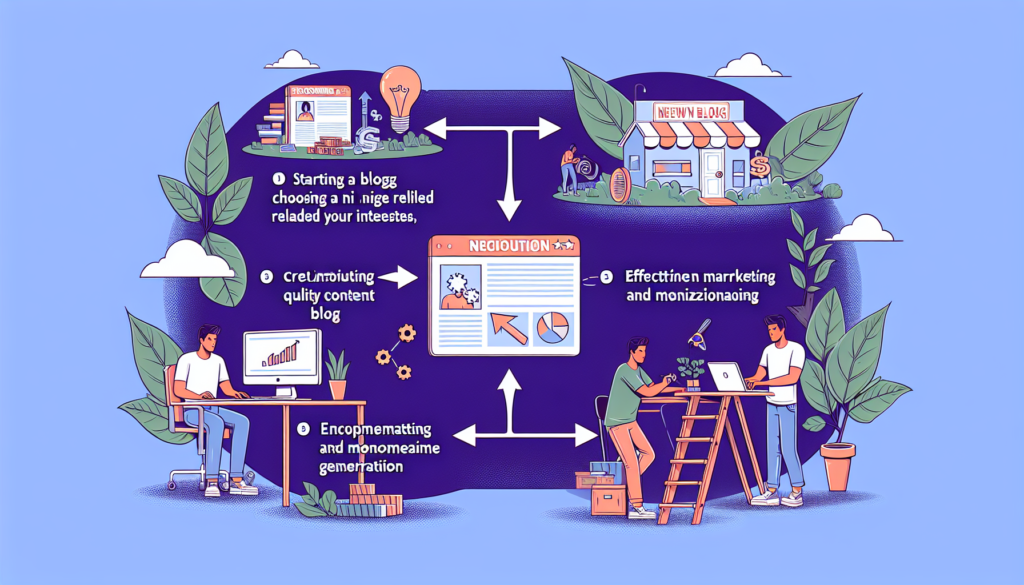So, you’ve got a passion for writing and you’ve always dreamt of sharing your thoughts and ideas with the world? Well, you’re in luck because starting a blog can be a great way to do just that, and even make a little money while you’re at it! In this article, we’ll walk you through the process of creating your own blog, from choosing a platform to monetizing your content. Whether you’re a seasoned writer or new to the world of blogging, we’ve got you covered with all the tips and tricks you’ll need to get started on this exciting journey. So, grab a cup of coffee and let’s dive into the wonderful world of blogging!

Choosing a Blogging Platform
Consider Your Goals
When choosing a blogging platform, it’s important to start by considering your goals. Are you looking to create a personal blog as a hobby, or do you have aspirations of turning it into a profitable business? Having clarity on your goals will help guide your decision-making process.
Evaluate Different Platforms
There are numerous blogging platforms available, each with its own set of features and benefits. Some popular options include WordPress, Blogger, and Wix. Take the time to research and compare different platforms, considering factors such as ease of use, customization options, and available plugins or themes.
Choose the Right Platform for You
Once you’ve evaluated different platforms, it’s time to choose the one that best aligns with your goals and needs. Consider factors such as the platform’s flexibility, user-friendliness, and scalability. It’s also worth considering any specific features or integrations you require, such as e-commerce capabilities or SEO tools.
Set Up Your Blog
After selecting a platform, it’s time to set up your blog. This involves selecting a domain name (the web address for your blog) and a hosting provider to make your blog accessible online. Choose a domain name that is memorable, reflects your blog’s topic or brand, and is easy to spell. Once you have your domain and hosting in place, follow the platform’s instructions to set up your blog, customize its appearance, and add any necessary plugins or widgets.
Identifying Your Niche
Research Popular Topics
To succeed as a blogger, it’s crucial to choose a niche or topic that has a substantial audience and potential for growth. Start by researching popular topics within the blogging community and identify trends or areas where there may be a gap or underserved audience.
Find Your Passion
While researching popular topics is essential, it’s equally important to find a niche that aligns with your passion and expertise. Blogging requires consistent effort and dedication, so it’s vital to choose a topic that genuinely excites you and that you can consistently create content about.
Assess Market Demand
In addition to your passion, it’s crucial to assess the market demand for your chosen niche. Is there a large and engaged audience for the topic you’ve chosen? Are there other successful blogs in the same niche? By conducting market research, you can validate the demand for your chosen niche and ensure there is potential for growth and monetization.
Define Your Target Audience
To effectively build an audience and create engaging content, you’ll need to define your target audience. Consider their demographics, interests, and pain points. By understanding your audience, you can tailor your content to their needs and preferences, ultimately attracting and retaining loyal readers.
Creating High-Quality Content
Craft Engaging Headlines
One of the keys to capturing the attention of your audience is crafting engaging headlines. Your headline should be concise, compelling, and give readers a clear idea of what they can expect from your post. Utilize action words, pose questions, or offer solutions to pique readers’ curiosity and entice them to click and read your content.
Write Valuable and Insightful Posts
The heart of any successful blog lies in its content. It’s crucial to provide your readers with valuable and insightful posts that they can’t find elsewhere. Share your knowledge, experiences, and unique perspectives on your chosen niche. Whether you’re providing informative guides, sharing personal stories, or offering practical advice, ensure that your content is well-researched, credible, and provides genuine value to your readers.
Use Visuals to Enhance Your Content
In addition to well-written text, incorporating visuals into your blog posts can significantly enhance the overall user experience. Visuals such as images, infographics, and videos can make your content more visually appealing and help to break up text-heavy sections. Visuals can also aid in conveying complex information or concepts in a more digestible and engaging manner.
Optimize Your Content for SEO
Search Engine Optimization (SEO) is essential to ensure your blog ranks well in search engine results and attracts organic traffic. Utilize relevant keywords throughout your content, optimize meta descriptions and title tags, and ensure your blog’s structure is search engine-friendly. Additionally, focus on creating high-quality and shareable content that naturally attracts backlinks from other reputable websites, further boosting your blog’s SEO efforts.
Building an Audience
Promote Your Blog on Social Media
Social media platforms provide fantastic opportunities to promote and grow your blog’s audience. Create profiles on platforms that align with your target audience, such as Facebook, Twitter, Instagram, or LinkedIn. Share your blog posts, engage with your audience, and participate in relevant discussions. Utilize social media scheduling tools to consistently share your content and reach a wider audience.
Engage with Your Audience
Building a loyal audience involves engaging with your readers and creating a sense of community. Respond to comments on your blog posts, interact with your audience on social media, and encourage discussion and feedback. Actively listen to your audience’s needs and preferences and incorporate their feedback into your content creation strategy.
Network with Other Bloggers
Networking with other bloggers is an excellent way to expand your audience and establish relationships within your niche. Engage with other bloggers by commenting on their posts, sharing their content, and participating in blogging communities or forums. Collaborate on guest posts or joint projects to tap into each other’s audiences and mutually benefit from the partnership.
Guest Post on Other Blogs
Guest posting involves contributing articles or content to other blogs within your niche. By guest posting on established blogs, you can expose your brand and content to a wider audience and drive traffic back to your own blog. Reach out to relevant bloggers in your niche and offer to contribute valuable and unique content that aligns with their audience’s interests.

Monetizing Your Blog
Displaying Advertisements
One of the most common ways to monetize a blog is through displaying advertisements. This can include banner ads, sponsored content, or sidebar ads. Consider joining advertising networks like Google AdSense to easily manage and display relevant ads on your blog. However, be mindful of not overwhelming your readers with excessive ads that can negatively impact the user experience.
Joining Ad Networks
In addition to displaying ads, you can join ad networks that connect bloggers with advertisers seeking to promote their products or services. Ad networks, such as MediaVine or Ezoic, can provide access to higher-paying advertisers and optimize ad placements on your blog to maximize revenue potential.
Utilizing Affiliate Marketing
Affiliate marketing involves promoting products or services and earning a commission for every sale or action generated through your referral. Research and join reputable affiliate programs within your niche, and promote products that align with your audience’s interests and needs. Incorporate affiliate links into your blog posts or utilize dedicated affiliate marketing plugins to streamline the process.
Creating and Selling Digital Products
Creating and selling digital products, such as e-books, online courses, or templates, can be a lucrative way to monetize your blog. Leverage your expertise and knowledge to create valuable resources that provide solutions or benefits to your audience. Utilize e-commerce platforms, such as Gumroad or Teachable, to set up your digital storefront and reach your target audience.
Implementing Effective SEO Strategies
Performing Keyword Research
Keyword research is crucial for understanding the search terms and phrases users are using to find content related to your niche. Utilize keyword research tools such as Google Keyword Planner or SEMrush to identify relevant keywords with high search volumes and low competition. Incorporate these keywords naturally throughout your blog posts to improve your SEO rankings.
Optimizing Your Blog’s Structure
A well-structured blog is essential for both user experience and search engine optimization. Optimize your blog’s structure by organizing your content in categories, using descriptive headings, and implementing a logical internal linking structure. Ensure your blog is mobile-friendly and loads quickly, as these are important ranking factors for search engines.
Creating Relevant and Engaging Content
Search engines prioritize relevant and engaging content that meets the needs of users. Focus on creating in-depth, comprehensive, and high-quality content that answers users’ questions and provides valuable insights. Incorporate relevant keywords naturally and utilize headings, bullet points, and images to enhance readability and user experience.
Building Quality Backlinks
Backlinks from reputable and authoritative websites are crucial for improving your blog’s SEO. Focus on building quality backlinks by guest posting, participating in interviews or collaborations, and creating unique and shareable content that naturally attracts backlinks. Additionally, reach out to other bloggers or industry experts for potential link-building opportunities and partnerships.
Utilizing Email Marketing
Building an Email List
Building an email list allows you to directly connect with your audience and nurture relationships beyond your blog. Offer valuable incentives, such as exclusive content or downloadable resources, in exchange for visitors subscribing to your email list. Utilize email marketing platforms like Mailchimp or ConvertKit to manage and automate your email campaigns.
Creating Compelling Email Campaigns
When sending email campaigns, ensure they are compelling, personalized, and provide value to your subscribers. Use catchy subject lines to increase open rates, segment your email list based on subscribers’ interests or demographics, and tailor your content to their preferences. Include a clear call to action and make it easy for subscribers to engage with your content or make purchases.
Offering Exclusive Content to Subscribers
Reward your subscribers with exclusive content or offers that are not available on your blog. This can include e-books, guides, templates, or discounts on your products or services. By providing added value to your subscribers, you can foster loyalty and incentivize them to remain engaged with your brand.
Segmenting Your Email List
Segmenting your email list based on subscribers’ interests, demographics, or engagement levels allows you to send targeted and relevant content. By tailoring your emails to specific segments, you can increase open and click-through rates and provide a personalized experience for your subscribers. Utilize automation features within your email marketing platform to streamline the segmentation process.
Analyzing and Refining Your Strategy
Tracking Your Blog’s Performance
Regularly track and analyze your blog’s performance using tools such as Google Analytics or WordPress plugins. Monitor metrics such as website traffic, bounce rate, time on site, and conversion rates. Identify patterns, trends, and areas for improvement to refine your blogging strategy and optimize your content to better meet your audience’s needs.
Analyzing Website Traffic
Understanding where your website traffic is coming from and which sources are most effective is crucial for optimizing your promotional efforts. Analyze your website traffic sources to identify which channels yield the highest quality traffic and conversions. Adjust your promotional strategies accordingly, allocating more time and resources to channels that generate the best results.
Monitoring User Engagement
Engaging and retaining readers is essential for blog success. Monitor user engagement metrics, such as average time on page, social shares, and comments, to gauge how well your content resonates with your audience. Use this data to identify popular topics, formats, or content types, and replicate their success in future posts.
Making Data-Driven Decisions
By analyzing and interpreting the data collected from your blog’s performance, website traffic, and user engagement, you can make informed decisions to refine your blogging strategy. Use the insights gained to identify areas of improvement, experiment with new content formats or marketing tactics, and optimize your blog to better serve your audience and achieve your goals.
Establishing Relationships with Brands
Building a Strong Online Presence
To establish relationships with brands, it’s crucial to build a strong online presence for your blog. Consistently produce high-quality content, engage with your audience, and maintain an active social media presence. Brands are more likely to collaborate with bloggers who have a solid reputation and a loyal following.
Writing Sponsored Posts
Sponsored posts involve collaborating with brands to create content that promotes their products or services. When writing sponsored posts, ensure they align with your blog’s niche and audience. Be transparent with your readers about the sponsored nature of the post and maintain authenticity by only partnering with brands you genuinely support or believe in.
Collaborating with Brands
Collaborating with brands goes beyond sponsored posts. Consider partnering with brands for giveaways, product reviews, or hosting joint events or webinars. Look for opportunities that align with your blog’s niche and allow you to provide value to your audience while showcasing the brand’s offerings.
Becoming an Influencer
Establishing yourself as an influencer in your niche can open doors to brand collaborations and potential monetization opportunities. Cultivate your expertise, build a strong online presence, and consistently create valuable content. Engage with your audience and demonstrate your influence by providing honest recommendations and insights that resonate with your readers.
Diversifying Your Income Streams
Exploring Different Monetization Methods
To maximize your blog’s income potential, consider diversifying your income streams. Explore different monetization methods, such as sponsored content, affiliate marketing, product sales, or online courses. By diversifying your income, you can mitigate risks and ensure a more stable and profitable blogging venture.
Creating Online Courses
If you have expertise or specialized knowledge in your blog’s niche, consider creating and selling online courses. Online courses provide a scalable and passive income stream. Utilize e-learning platforms like Teachable or Udemy to create and market your courses. Ensure your courses are well-structured, engaging, and provide genuine value to your students.
Offering Coaching or Consulting Services
Monetize your expertise by offering coaching or consulting services to your audience. Leverage your blog and online presence to establish yourself as a trusted authority in your niche. Offer one-on-one coaching sessions, personalized consulting, or group coaching programs to individuals or businesses seeking your expertise.
Creating and Selling Physical Products
In addition to digital products, consider creating and selling physical products related to your blog’s niche. This can include merchandise, branded products, or niche-specific items that resonate with your target audience. Utilize e-commerce platforms or partner with print-on-demand services to manage inventory, fulfillment, and shipping logistics.
By following these comprehensive guidelines and implementing the strategies discussed, you can set yourself up for success in the world of blogging. Remember to stay committed, consistently create high-quality content, nurture relationships with your audience and brands, and always be open to adapting and refining your approach. With time, effort, and the right strategies, you can turn your blog into a profitable venture that fulfills your goals and brings value to your readers.

Paul is a digital marketing and blogging specialist who shares his knowledge and experience on his blog. He writes about topics such as SEO, PPC advertising, social media marketing, content marketing, email marketing, analytics and much more. Paul’s goal is to provide his readers with the information and resources they need to create and implement successful digital marketing campaigns and a profitable blog.
